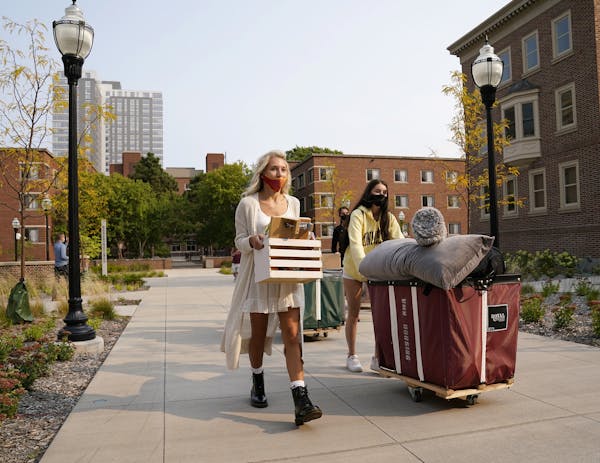Minnesota's COVID-19 dashboard reported Tuesday that a new high of 38% of confirmed novel coronavirus infections came from unknown community sources.
The rate is above Minnesota's goal of no more than 30%, meaning the SARS-CoV-2 virus is spreading beyond the state's ability to track it and contain it.
While it's impossible to identify all sources of COVID-19, state health officials said this increase was an expected result of rising infection numbers and viral spread. They urged people to reduce their risks through mask-wearing and social distancing, which in turn will cut the rate of unknown infections.
"It is reasonable that with increasing cases there is increased chance to acquire the virus in the community without knowing from whom or where," said Kris Ehresmann, state infectious disease director. "It is a concerning yet anticipated trend when cases increase."
The Minnesota Department of Health on Tuesday reported four COVID-19 deaths and 954 lab-confirmed infections, bringing the state's totals in the pandemic to 2,087 deaths and 105,740 infections.
The number of admissions of Minnesotans to hospitals because of COVID-19 showed signs of stabilizing after an uptick last month. The average seven-day total of hospital admissions exceeded 400 for much of last week, but was only 381 for the seven-day period ending Sept. 30. That remains above the average admission numbers for most of the summer, though.
Unknown community transmission is the most common determination of a lab-confirmed infection, meaning that a person tested positive but couldn't identify who might have been the source of the virus. That is the determination for 27,606 lab-confirmed infections, while 24,245 have been linked to known community sources such as contact with infected people at home or work, or outbreaks at bars or social settings.
Another 17,392 infections are listed as unknown or missing exposures, meaning that contact tracers never reached people for interviews or are still investigating.
COVID-19 numbers have increased this fall in lockstep with a rise in diagnostic testing, including free clinics statewide that raise the potential for finding people with little or no symptoms who don't know how they were infected.
The state reported a record 166,736 diagnostic COVID-19 tests in the seven-day period ending Oct. 4.
Ehresmann said more public health workers have been assigned to interviewing in order to keep up with the rising number of infected people and to identify their close contacts who are at risk for illness and spreading the coronavirus.
The unknown community transmission rate had dropped to 31% at the end of August before rising. The lowest recorded rate was 10% on April 22, when the majority of confirmed infections were easily traceable to outbreaks in food-processing plants and long-term care facilities. The rate hasn't been below the state target of 30% since July 3.
Gov. Tim Walz said last month that he would like to see the rate of unknown community transmission drop to 20% and the positivity rate of diagnostic testing drop to 4%, before withdrawing social distancing guidance and capacity restrictions on indoor spaces and large group gatherings. The state also has a mask-wearing mandate in effect for indoor public spaces and outdoor workplaces where social distancing is impractical.
The U.S. Centers for Disease Control and Prevention on Tuesday issued a report backing the effectiveness of such steps, showing that confirmed infections increased by 151% in Arizona after the lifting of a stay-at-home order, then decreased 75% shortly after mask-wearing and limited business restrictions were imposed. The report notes the drop could have been coincidental to the policy changes, but ultimately concluded that such steps can reduce viral transmission.
One challenge for identifying likely transmission sources is that some infections are due to tiny virus-carrying aerosols that linger in the air. While most infections are due to larger droplets spreading directly from infected people who are 6 feet or less away, the CDC formally acknowledged on Monday that aerosols "sometimes" play a role.
State health officials on Monday said the formal CDC acknowledgment was a good thing, but that they had already accounted for the risks of aerosol spread of the coronavirus — though they emphasized that it is much less of a risk for airborne transmission when compared to other pathogens such as the measles virus.
"Any time you have a situation in which you're indoors with lots of people and you don't have the opportunity to be distanced and you have poor ventilation, that is sort of a recipe for problems with COVID," Ehresmann said.
The CDC on Monday reported a remarkable outbreak in which the virus spread from a 13-year-old to 11 of 13 other relatives staying together in a house for a three-week gathering. Six relatives who visited, but didn't go in the house, were not infected.
Minnesota health officials on Monday reported that the positivity rate of diagnostic testing is 5.2%, down slightly from the rate reported last week of 5.4%.
The four deaths reported Tuesday included two people in their 60s and two people in their 80s. Age and underlying health problems remain key risk factors for severe COVID-19 illness and death. More than 80% of the state's COVID-19 deaths have involved people 70 or older.
Jeremy Olson • 612-673-7744
8 months in jail for Blaine man who caused 120-mph crash hours after he was caught speeding

Daughter sues St. Paul, two officers in Yia Xiong's killing

